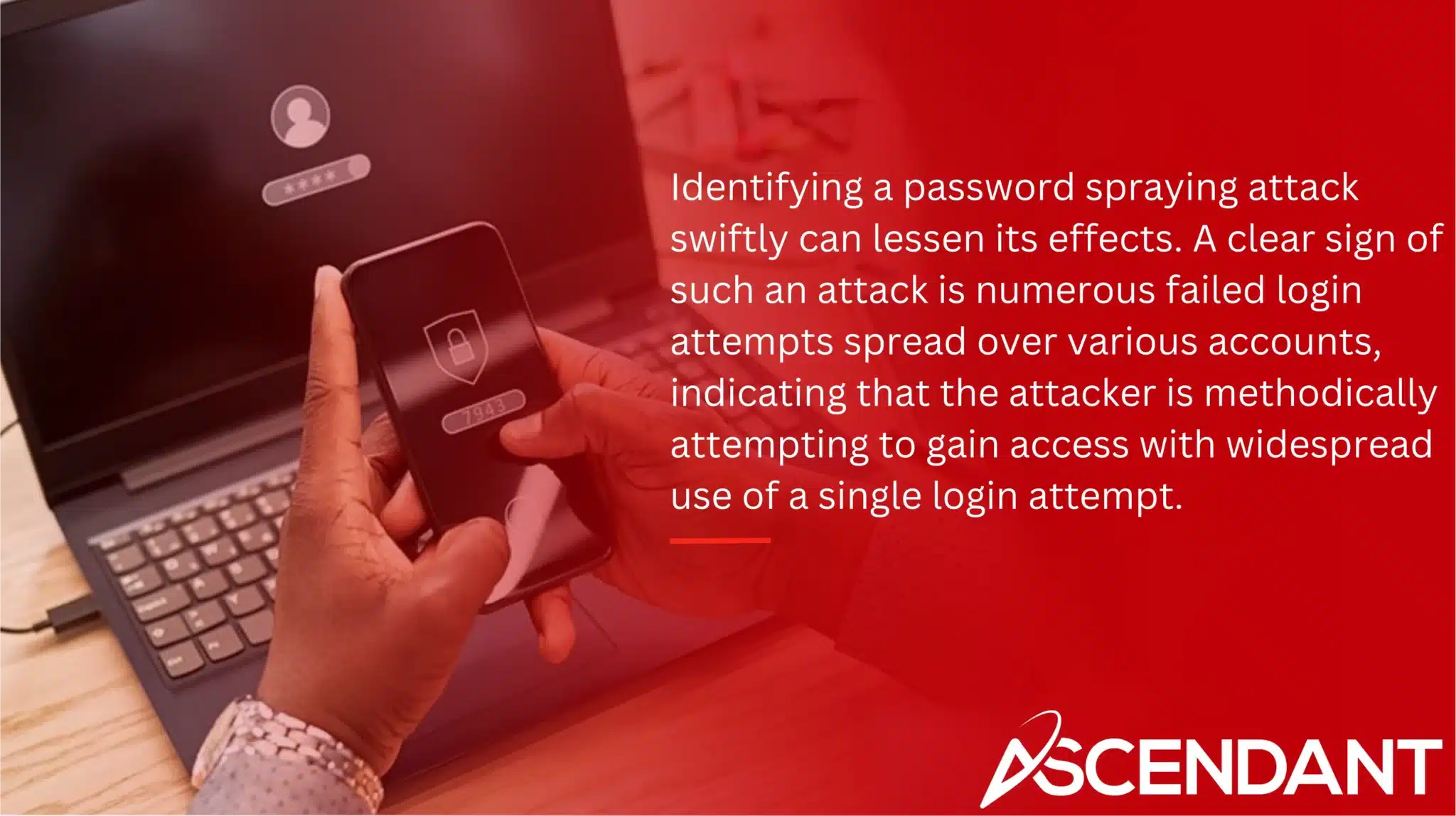Password spraying involves using one password across many accounts to avoid detection. This method exploits weak passwords and can cause significant breaches. This article explains how password spraying works, its impact, and ways to protect against it.
In This Article:
- Understanding Password Spraying Attacks
- How Password Spraying Attacks Are Conducted
- Impact of Password Spraying Attacks on Organizations
- Common Indicators of Password Spraying Attacks
- Techniques to Detect Password Spraying Attacks
- Preventative Measures Against Password Spraying Attacks
- Case Studies of Password Spraying Attacks
- Advanced Security Measures
- Role of Password Managers in Preventing Password Spraying Attacks
- The Future of Password Security
Key Takeaways
- Password spraying attacks exploit weak passwords across multiple accounts, making them harder to detect than traditional brute-force attacks.
- Implementing strong password policies, multi-factor authentication, and user education are essential measures to mitigate the risk of password spraying attacks.
- Advanced security techniques like Zero Trust models and password managers can significantly enhance an organization’s defense against these attacks.
Understanding Password Spraying Attacks
A spraying attack is a distinct form of brute force attack that attempts to gain unauthorized access by applying the same password across various accounts instead of testing numerous passwords against one single account. By dispersing authentication attempts in this way, these attacks circumvent triggering lockouts on any specific account, which makes them less noticeable than traditional brute force attacks.
Due to widespread use of weak passwords among many users, who often repeat their simple and guessable passwords across different services, password spray attacks are notably effective. As a result, settings where such vulnerable passwords are commonly used become prime targets for attackers using this spraying method.
How Password Spraying Attacks Are Conducted
In password spraying attacks, there is a distinctive two-phase approach. The initial step involves assembling an array of usernames which attackers often obtain by exploiting standardized email formats or extracting them from earlier security breaches. Following the collection of usernames, these cyber intruders apply a widely used password to each account one after another to avoid setting off any red flags that could result in account lockouts.
The execution of these spraying attacks relies heavily on automation tools that enable bad actors to rapidly test various combinations of usernames and passwords within limited periods. Typically, they initiate their efforts with the most prevalent passwords and progress through their list should they not immediately break through an account’s defenses. This strategy capitalizes on the tendency among users to choose simple and well-known passwords for ease.
Should an attacker successfully infiltrate an account using a common password, it opens up opportunities for System penetration and access compromise across additional accounts or services connected to the breached user profile. Employing this methodical attack pattern allows assailants both subtlety in avoiding detection as well as efficiency—in terms of time invested relative to potential breach gains—by leveraging such minimal effort schemes against vulnerable accounts sharing similar weaknesses in password security practices.
Impact of Password Spraying Attacks on Organizations
An organization can suffer severe consequences from a successful password spraying attack. These types of attacks might cause major data breaches, leading to the loss of sensitive information and considerable financial losses that stem from incident response expenses and possible penalties. After a breach occurs, there is often an erosion in customer trust which may lead to reduced sales and a decline in long-term revenue.
Password spraying attacks also pose serious threats to operational continuity. They have the potential to drastically reduce efficiency or bring organizational productivity to a complete standstill, thereby harming business operations. The combined effect of financial damage, reputation harm, and operational setbacks highlights the essential need for strong security defenses against these types of attacks.
Common Indicators of Password Spraying Attacks

Identifying a password spraying attack swiftly can lessen its effects. A clear sign of such an attack is numerous failed login attempts spread over various accounts, indicating that the attacker is methodically attempting to gain access with widespread use of a single login attempt.
Additional indicators include a significant uptick in locked-out accounts and abrupt increases in authentication requests over brief periods. Atypical access timings and geolocations may also signal illicit login attempts tied to a spraying attack. Early detection of these symptoms enables quick action to counteract the assault.
Techniques to Detect Password Spraying Attacks
Vigilant and multi-faceted surveillance is crucial for identifying password spraying attacks. By integrating monitoring systems that can detect atypical login behaviors, organizations can significantly enhance their security posture. It’s important to meticulously record every authentication attempt and conduct routine examinations of these records to pinpoint any indications pointing toward an ongoing spraying attack.
Employing methods like tracking irregular patterns in logins, observing surges in activity from accounts that are typically inactive, and setting definitive limits on permissible failed login attempts are pivotal components. Utilizing behavior-oriented threat detection models along with keeping an eye on account lockouts may also serve as preliminary indicators of a potential spraying attack.
Synthesizing assorted techniques increases the likelihood of promptly spotting questionable activities. For swift recognition of such issues, it’s advisable to calibrate security logging frameworks so they zero in on unsuccessful login efforts and other anomalous patterns indicative of widespread authentication attempts.
Preventative Measures Against Password Spraying Attacks
In order to combat password spraying attacks, it is critical to employ a multi-pronged strategy. Initial, instituting rigorous password policies can greatly diminish the likelihood of such attacks. Prohibiting the use of frequently chosen passwords across an organization stands as a key measure towards this goal.
Adding multi-factor authentication (MFA) serves as an additional safeguard that significantly complicates efforts for intruders attempting to breach systems without authorization. Raising awareness amongst users about safe security practices plays an integral role in reducing vulnerability to password spraying attacks. Employing these strategies collectively forms a formidable barrier against potential threats of this nature.
Enforcing Strong Password Policies
Implementing robust password policies is essential in thwarting password spraying attacks, where attackers use common passwords to gain unauthorized access to multiple accounts. These security measures reduce the likelihood of successful breaches by promoting diversity in characters and enforcing longer passwords. To avoid simple or widely used phrases and discourage repeated use across various accounts, these guidelines should underscore the necessity for intricate passcodes.
It’s vital that entities lay out unambiguous directives for establishing strong passwords and strictly enforce them. Resources such as Active Directory Password Protection serve as useful allies in curtailing the selection of prevalent passwords among staff members, thereby aligning with optimal standards for generating secure credentials.
Implementing Multi-Factor Authentication (MFA)
Adopting multi-factor authentication (MFA) substantially bolsters security defenses. It adds a critical layer of protection against password spraying attacks by demanding extra verification beyond the standard password requirement, which may involve knowledge-based information like a password, possession-based factors such as a mobile device, or inherent traits like biometric data.
It is essential to train users in secure MFA practices. They need to appreciate the importance of MFA and how to prevent fatigue-related issues while using it. When organizations integrate MFA into their security strategy, they significantly improve their resilience against potential password spraying attacks.
Educating Users on Security Best Practices
Educating users plays a vital role in thwarting password spraying attacks. Consistent instruction on identifying phishing schemes and the significance of crafting strong passwords substantially diminishes the associated dangers. It’s important that employees receive ongoing guidance on security best practices and are informed about the potential risks introduced by password spraying assaults.
Streamlining the procedure for flagging suspect behavior can also enable users to respond swiftly upon detecting any anomalies. Promoting the adoption of password managers is advisable as it assists individuals in generating and maintaining distinctive, intricate passwords, thereby augmenting overall security measures.
Case Studies of Password Spraying Attacks
The rise in password spraying attacks has had a significant impact, with even high-profile organizations falling victim. For example, the Russian state-sponsored hacking group Midnight Blizzard took advantage of an unprotected Microsoft account without multi-factor authentication in January 2024 and succeeded in breaching sensitive corporate emails. This incident serves as a stark warning about the necessity for stringent security protocols.
Peach Sandstorm, another government-supported cyber team from Iran, also prominently incorporated password spraying tactics into their digital espionage strategies. These events highlight the considerable risks posed by nation-state actors engaging in these types of cyberattacks.
These practical instances act as forceful alerts to the potential consequences of such attacks and reinforce just how crucial it is that entities enforce all-encompassing security defenses to shield themselves against similar menaces.
Advanced Security Measures
To stay ahead of advanced attackers, implementing robust security measures is crucial. Adopting a Zero Trust model can be particularly effective, as it limits access to the necessary resources at any given time and consistently verifies the user’s identity throughout their session. This method significantly reduces the chances of unauthorized entry even when credentials are compromised.
Incorporating behavioral biometrics into your security strategy can provide additional defense against automated dangers such as password spraying attacks by ensuring that users must physically authenticate themselves, thereby adding an extra layer of protection.
The development of passkeys and cryptographic solutions presents new avenues for secure authentication by eliminating traditional passwords and diminishing phishing threats. As we move towards passwordless options in securing digital identities, leveraging AI-driven techniques for detecting threats along with enhancements in biometric technologies will become increasingly important in fortifying security frameworks.
Role of Password Managers in Preventing Password Spraying Attacks
In combatting password spraying attacks, the utilization of password managers plays a crucial role. These tools aid in creating and storing robust, distinct passwords for every account, thus bolstering security across all user accounts. Securely housed within the manager, these complex login credentials become more manageable for users to handle.
Employing a password manager can help avoid the widespread error of recycling passwords on various accounts, which diminishes the threat posed by such spraying attacks. As they facilitate both generation and safekeeping of intricate passwords, password managers are essential elements in strategic measures designed to thwart attempts at conducting password spraying assaults.
The Future of Password Security
Transitioning away from conventional passwords is crucial for enhancing password security in the future. User access methods that utilize biometrics or voice activation can dispense with passwords entirely, offering a more secure and convenient way to authenticate users. Numerous organizations remain dependent on passwords because of their established systems.
The journey toward adopting alternatives to traditional passwords is impeded by difficulties such as diverse nomenclature and disparate system configurations. Yet, with an increasing number of entities adopting solutions like passkeys, authentication via biometrics, and artificial intelligence-based threat detection mechanisms, the domain of password security will keep transforming. This evolution will lead to strengthened defenses against dangers such as spraying attacks targeting passwords.
Summary
In summary, organizations face a substantial risk from password spraying attacks that leverage poor password habits to infiltrate systems without permission. It’s essential for these entities to comprehend the mechanics and consequences of such assaults in order to establish formidable defenses. Strengthening password policies, deploying multi-factor authentication, and teaching users about secure practices are effective strategies for mitigating the dangers posed by spraying attacks.
Elevated security protocols and employing password management tools bolster safeguarding efforts. As we look ahead, advancements in password protection hold promise for even stronger preventive measures against unauthorized access attempts. Maintain alertness, embrace holistic security tactics comprehensively, and persistently educate both yourself and your organization on emerging cyber threats to remain one step ahead.
 Frequently Asked Questions
Frequently Asked Questions
What is a password spraying attack?
A password spraying attack involves using a single password across multiple accounts to evade detection and minimize account lockouts.
This method aims to exploit weak password practices effectively.
How can I detect a password spraying attack?
To effectively detect a password spraying attack, you should monitor for frequent failed login attempts and any unusual patterns in authentication requests.
This vigilance will help you identify potential threats early on.
What are the impacts of a password spraying attack on an organization?
A password spraying attack can lead to severe consequences for an organization, including data breaches, financial losses, reputational damage, and operational disruptions.
Protecting against such threats is crucial for maintaining security and trust.
How can password managers help prevent password spraying attacks?
By creating and safeguarding robust, distinctive passwords for every account, password managers serve as an efficient tool against password spraying attacks. This reduces the dependency on easily guessable or recycled passwords.
Implementing this strategy considerably bolsters your cybersecurity defenses overall.
What advanced security measures can be taken to prevent password spraying attacks?
In order to safeguard against password spraying attacks, it’s advisable to adopt a Zero Trust security framework, employ behavioral biometrics for user verification, and embrace cutting-edge solutions like passkeys along with biometric authentication methods.
Taking these steps will considerably strengthen your defensive stance against such spraying attacks.

